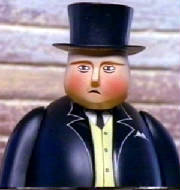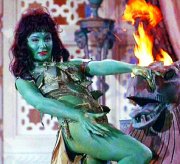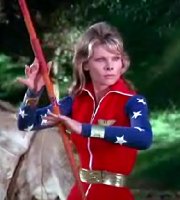My kids have outgrown it by now, but for a few years there our household was swimming in Thomas the Tank Engine videos and toys, and I could tell you the name, color, function, and personality of every engine on picturesque Sodor, and so could my wife and kids. I was amazed by that — and am now equally amazed at how quickly (and mercifully!) it has all faded from memory.
I wrote the following at the peak of our Thomasmania and dedicate it to all parents of Thomas-obsessed toddlers who think this phase will never end. It will.
It was a beautiful day on the island of Sodor. [Engine X] was very excited — today was the day of [an annual celebration or completion of a major construction milestone]. As [Engine X] chattered about it with the other engines in the shed, Sir Topham Hatt came to see him.
“[Engine X],” he said, “today I have an important job for you. You must ferry the [children, celebrants, performers, or party goods] to the [celebration].”
“Oh my,” said [Engine Y] to [Engine X]. “That means you’ll have to [traverse a notoriously tricky section of track]. Be sure to [travel at an appropriate speed].”
“I’m sure I always do,” sniffed Gordon.
On his way to [yet another among tiny Sodor’s impossibly many stations], [Engine X] grew more and more excited and started to sing a happy song. “Oh, I’m going to pick up the [children, celebrants, performers, or party goods],” he sang as he chuffed along. He was having so much fun that he forgot all about [traveling at an appropriate speed]. Closer and closer loomed the [notoriously tricky section of track] until, all of a sudden–!
(Here [Engine X] makes an off-track excursion and causes property damage.)
 Fortunately, no one was hurt. A short time later, Sir Topham Hatt arrived. He was very cross. “[Engine X], you were not paying attention. You have caused confusion and delay. I have asked [Engine Y] to take your place. You must go back to the shed for repairs.”
Fortunately, no one was hurt. A short time later, Sir Topham Hatt arrived. He was very cross. “[Engine X], you were not paying attention. You have caused confusion and delay. I have asked [Engine Y] to take your place. You must go back to the shed for repairs.”
“I’m sorry,” said [Engine X]. He felt terrible. Not even jolly Harvey could cheer him up as he helped pull [Engine X] back onto the tracks. Now [Engine X] would not get to carry the [children, celebrants, performers, or party goods], and he wouldn’t even be able to attend the [celebration]!
On his way back to the shed, [Engine X] passed [Engine Y]. “Hi, [Engine X]!” called [Engine Y] cheerfully. “Hello,” replied [Engine X] glumly. As they passed, [Engine X] noticed [a condition with negative consequences for safety]. “I must alert [Engine Y, Sir Topham Hatt, or the switchman]!” thought [Engine X]. So he raced to [the celebration] and [averted a disaster].
Everyone cheered for [Engine X]! Sir Topham Hatt said, “You are a really useful engine.”
And he was.
 Among the very earliest artifacts available for Star Trek fans to own was the book, The Making of Star Trek, by Stephen E. Whitfield and Gene Roddenberry, and I read it in the 70’s.
Among the very earliest artifacts available for Star Trek fans to own was the book, The Making of Star Trek, by Stephen E. Whitfield and Gene Roddenberry, and I read it in the 70’s. One anecdote that I remember from that book had to do with production of the original pilot episode, “The Cage.” In one scene, the actress Susan Oliver dances as a seductive “Orion slave girl,” covered from head to foot in green body makeup. The optical lab that processed the film footage from those scenes believed they had screwed up — and they color-corrected Oliver back to her normal skin tone! As I recall the story, this happened two or three times before the studio finally sent explicit instructions to the lab and they got it right.
One anecdote that I remember from that book had to do with production of the original pilot episode, “The Cage.” In one scene, the actress Susan Oliver dances as a seductive “Orion slave girl,” covered from head to foot in green body makeup. The optical lab that processed the film footage from those scenes believed they had screwed up — and they color-corrected Oliver back to her normal skin tone! As I recall the story, this happened two or three times before the studio finally sent explicit instructions to the lab and they got it right.
 Scofield holds up a bank in order to get arrested and imprisoned. Although this scene is set in Chicago, the exterior shot of the bank he robs is of the distinctive-looking
Scofield holds up a bank in order to get arrested and imprisoned. Although this scene is set in Chicago, the exterior shot of the bank he robs is of the distinctive-looking  [Updated: inline video player removed due to errors in certain browsers.
[Updated: inline video player removed due to errors in certain browsers.  Cathy Lee in this movie was my second TV crush, after Nancy, the irrepressible nine-year-old from the original 1972
Cathy Lee in this movie was my second TV crush, after Nancy, the irrepressible nine-year-old from the original 1972  A little later, while we were watching another episode, Andrea came home. I asked her, “Can you guess whose voice that is doing the narration?”
A little later, while we were watching another episode, Andrea came home. I asked her, “Can you guess whose voice that is doing the narration?”